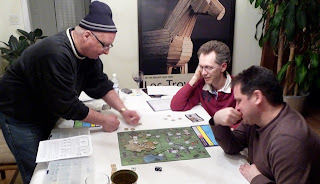 The surface is a sea textured mat that Curt graciously lent to me. In the above picture, the three Directorate cruisers are forming into a line of battle in the upper left while my battleship, in the lower left, escorted by frigates, prepares to deliver deadly broadsides.
The surface is a sea textured mat that Curt graciously lent to me. In the above picture, the three Directorate cruisers are forming into a line of battle in the upper left while my battleship, in the lower left, escorted by frigates, prepares to deliver deadly broadsides.
 Maybe not so deadly... I soon discovered that Directorate ships are more efficient when firing in multiple arcs. So my best approach would have been to move within the enemy formation. I guess I was using outdated tactics from the age of sail.
Maybe not so deadly... I soon discovered that Directorate ships are more efficient when firing in multiple arcs. So my best approach would have been to move within the enemy formation. I guess I was using outdated tactics from the age of sail.
 But it was now too late as my last cruiser blew up into a miniature supernova.
But it was now too late as my last cruiser blew up into a miniature supernova.
Overall, it was a good introductory game. The Firestorm Armada game engine is really simple and fun. You activate your squadrons (from 1 to 3 ships) one at a time and perform all your moves and attacks for that squadron before inviting your opponent to activate a squadron. You damage ships by accumulating hits up to a certain threshold. And you get to roll LOTS of dice. There is a rule refered to as "explosive 6s". Whenever you roll a "6", you score two hits and get to re-roll. Although unlikely, it would not be impossible for a single fighter rolling 6s after 6s to blow up a battleship. Squadrons get to link fire, which adds to the number of dice. The cards add some unforeseen events, without completely shifting the battle from one side to another. It was good to have some space action.
























